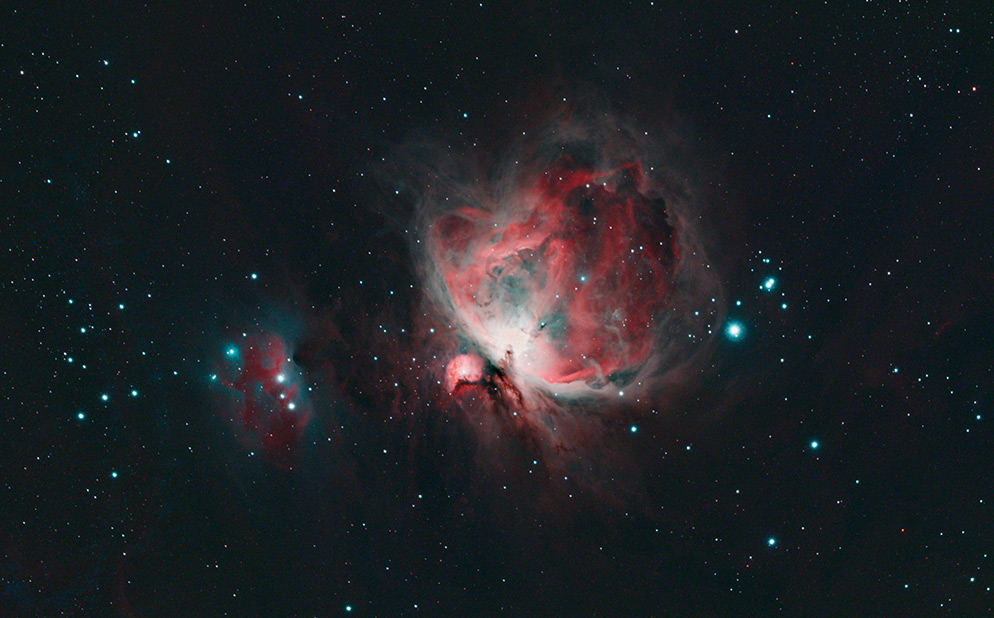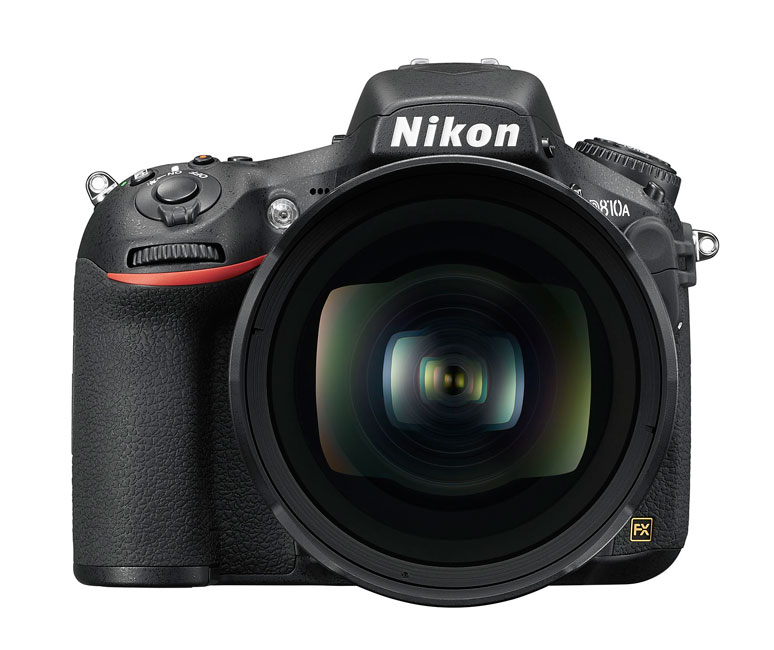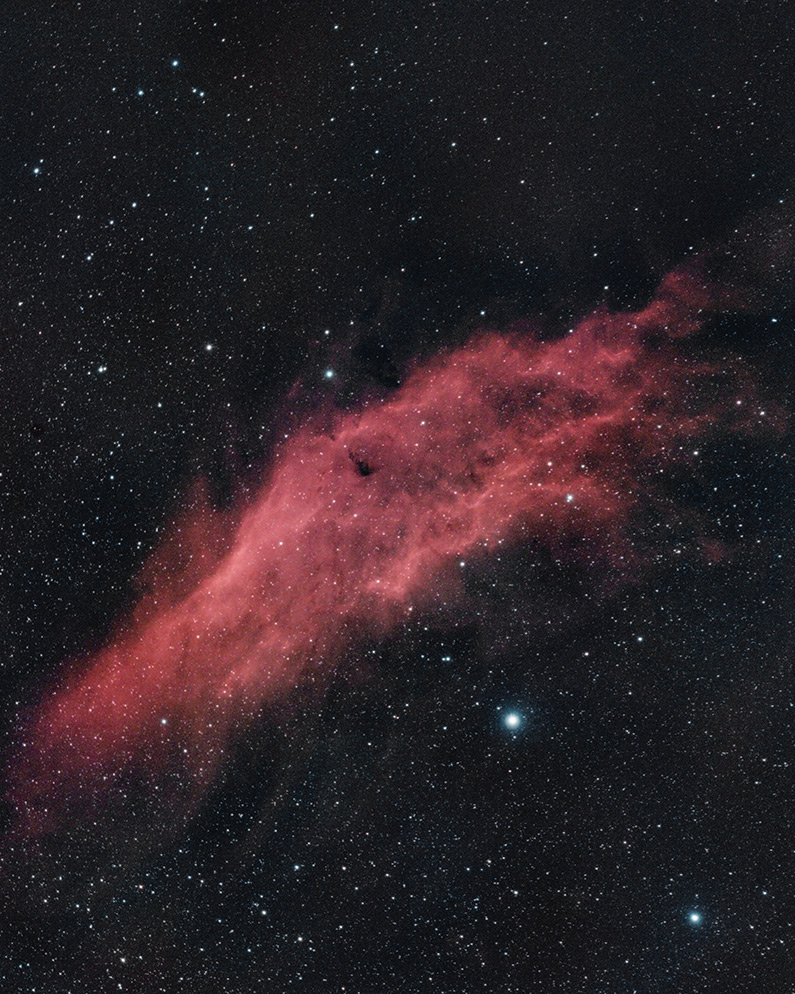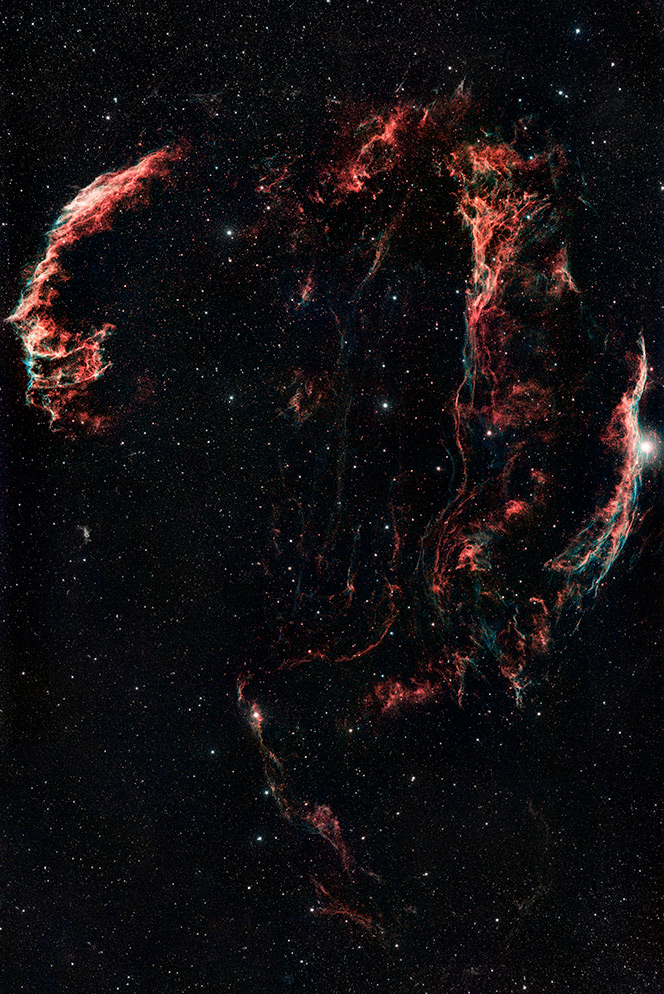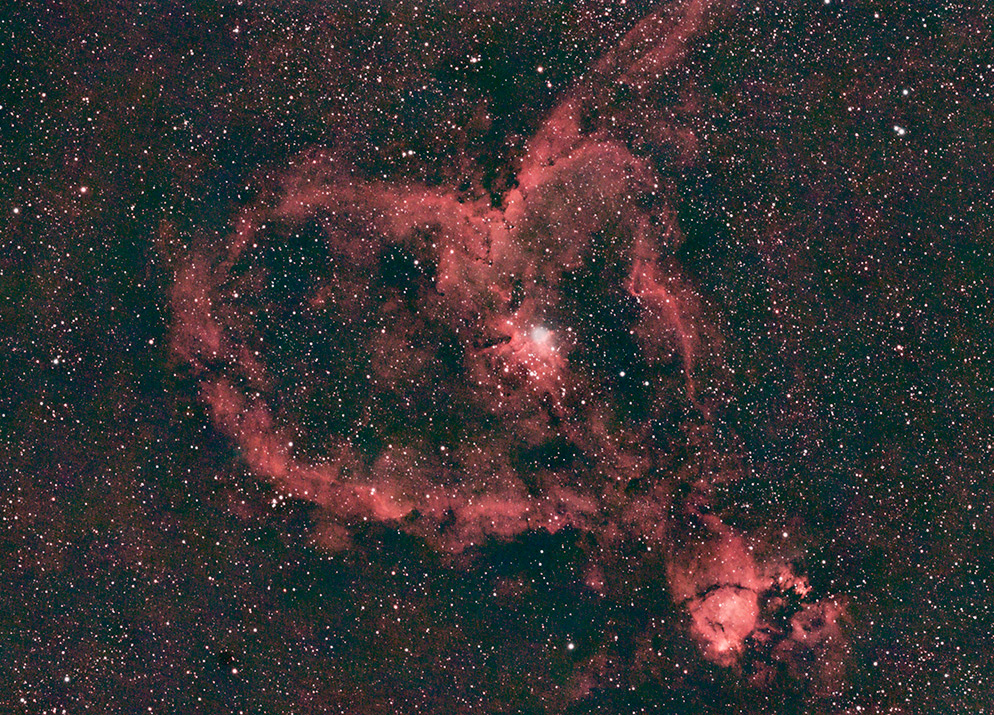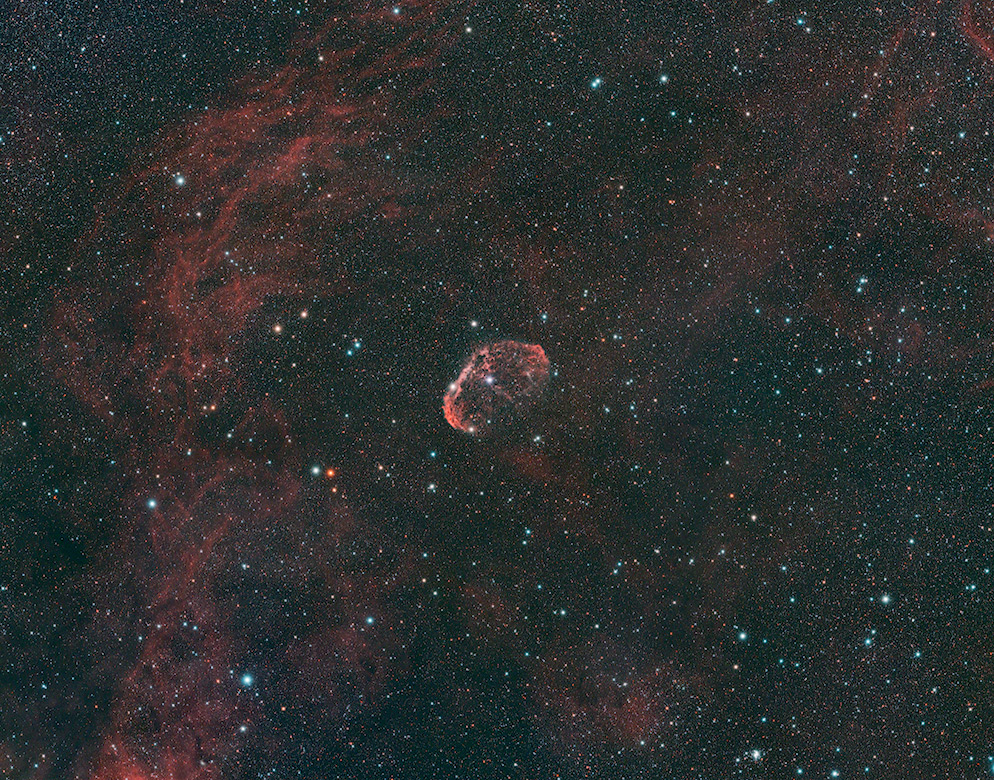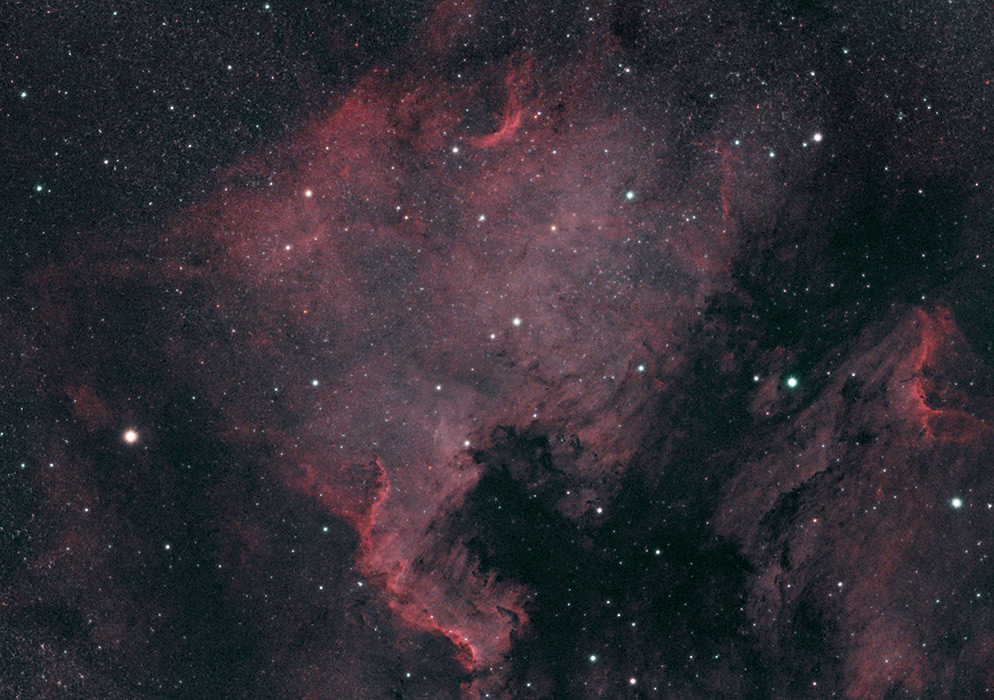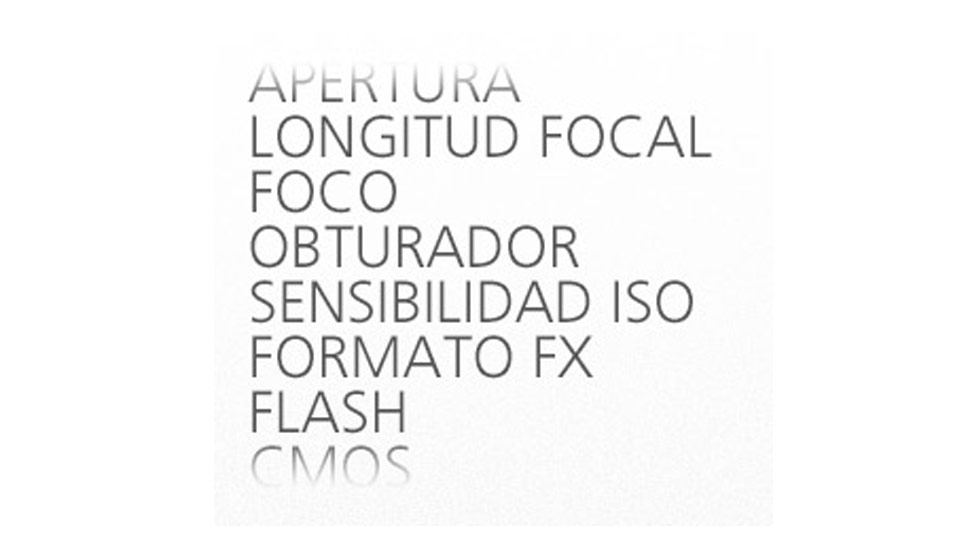Using the D810A DSLR for Deep Space and Nebulae Astrophotography
M42 Orion Nebulae - Photographed with a Nikon D810A combined with an Explore Scientific ED80 telescope (480mm focal length), mounted on a Skywatcher EQ6 equatorial mount. An Optolong L-eNhance filter was used to help with light pollution. All images were calibrated with Bias, Dark and Light frames. All images were processed using PixInSight & Adobe Photoshop. This is a HDR image comprised of 4 different exposure times: 7 frames at 6 minutes per frame. 11 frames at 5 minutes per frame. 47 frames at 45 seconds per frame. 54 frames at 10 seconds per frame. Total integration time: 2.4 hours.
Nikon designed the D810A DSLR exclusively for those photographers who shoot astrophotography, specifically those who want to capture deep space images of clouds of gas and dust known as nebulae. The camera is uniquely designed to capture nebulae rich in H-alpha emission. [Read the sidebar below for a greater explanation of H-alpha.] Ideal subjects for use with the camera include deep space imagery of nebulae, galaxies and clusters as well as constellations and our local solar system.
Photographs of Earth’s moon, and the planets in our local solar system, as well as constellations and the edge of our own galaxy—the Milky Way—can be captured using wide-angle lenses that allow you to include a terrestrial foreground.
Prior to the release of the D810A, a popular way to use a DSLR to shoot vibrant H-alpha nebulae would be to have a camera modified after purchase, which would void the warranty. Since the D810A incorporates a special IR Cut filter to allow you to shoot H-alpha nebulae at 4x the contrast than with a normal DSLR, modification is not necessary and your warranty is maintained. However, with the addition of this IR Cut filter, this means that the camera is not well suited for normal photography—and a color shift will occur if you use the camera in daylight or for flash photography. This camera is designed exclusively for night landscapes and astrophotography.
The best conditions for capturing beautiful images of the night sky are clear skies with low light pollution and low activity in the atmosphere from winds and moisture, also little or no moonlight that could outshine the stars or other celestial objects you’re trying to photograph.
When shooting solar eclipses with the D810A attached to either NIKKOR lenses or a telescope, you don’t want to point the camera at the sun without the proper solar eclipse filters attached. Doing so can cause damage to your eyes and the camera’s image sensor.
Deep sky photography essentials
A telescope—since deep sky photography typically requires long exposures, having a telescope capable of tracking the object is very beneficial, and having one on a heavy-duty polar aligned equatorial mount is best. Add an F-mount camera adapter (optional, not sold by Nikon) used to connect the D810A to the telescope and maybe a cable release or wireless remote (see accessories listed at bottom of page) and you’re set. This camera imaging system is complete; the images are recorded to the camera’s memory card unlike many other camera designs used for astrophotography
Alternatively, you can use a NIKKOR super-telephoto lens, 200mm and longer, attached to the D810A as well, especially for lunar and planetary image capture. Again, a very stable tripod is recommended.
Your choice of telescopes will depend on many factors. There are many types of telescopes—most commonly used are either refracting or reflecting types. The difference is in the way each telescope gathers light. A refracting telescope collects light through a series of lenses. The light enters the telescope and is focused through a lens, onto a second lens, and so forth then through the eyepiece for the user to view. These telescopes are easier to maintain and are usually the choice for beginners.
A reflecting telescope collects light using mirrors, which bounces the light onto a secondary mirror and into the eyepiece. Some other designs use a combination of lenses and mirrors to capture and direct light. Generally refractors capture a smaller field of view, which requires more precise location and tracking, but the detail through quality optics is usually better.
In order to capture stars as points of light, you either need to use relatively short exposure times or place the camera on a telescope with a polar aligned equatorial mount. An equatorial mount allows the telescope and camera to be set parallel to the earth’s rotation. Combine this with a clock drive operating in the opposite direction, and you can effectively counter the earth’s spin and freeze your subject allowing for very long exposures without movement.
The tripod you use should also be sturdy enough to resist wind. These may be weighed down with additional weights or sand bags.
To ensure you don’t cause blurring of your images when you snap each shot, use a remote cord or wireless remote instead of pressing the camera’s shutter button. You could also use the self-timer button along with exposure delay mode, or Mirror Up mode with electronic front curtain shutter for the least amount of internal camera vibration.
When you’re using a camera lens instead of a telescope, remember to place the lens hood on the lens. It will help keep out extraneous light and also help keep dew from forming on the lens surface.
Nikon’s Capture NX-D software also offers an astrophotography noise reduction feature that will reduce the noise in photographs of stars and constellations without wiping out the pinpoint stars you’ve worked so hard to capture.
The workflow for processing photographs of H-alpha nebula, clusters, star fields and galaxies includes prepping the images (dark-frame subtraction, flat-field correction and compositing), image adjusting (levels, tone curves and color adjustments), and finishing (sharpening and smoothing) to bring out the detail and vibrant red colors. The processing of images is done using third party software.
Using wide-angle lenses to photograph constellations
Wide-angle lenses are also used in astrophotography, to capture wide vistas that include terrestrial foreground elements such as trees and mountains along with constellations or our Milky Way galaxy. Photographers who enjoy photographing star trails also use wide-angle lenses for these images, so they can capture the same objects in the foreground, oftentimes even illuminating the foreground elements using flash or constant light sources.
Some of the popular NIKKOR wide-angle lenses for astrophotography include: AF-S NIKKOR 14-24mm f/2.8G ED, AF-S NIKKOR 24-70mm f/2.8G ED, AF-S NIKKOR 58mm f/1.4G, AF-S NIKKOR 24mm f/1.4G ED. See the article on photographing the night sky to learn more about shooting these types of images.
Astrophotography specific features of the D810A
-
The D810A offers a wide range of features that make it a great choice for deep space photography. First, the camera is the only DSLR in the market designed specifically for capturing H-alpha nebulae, that uses a 36 megapixel full frame FX format image sensor (24mm x 36mm). The IR filter in the D810A is optimized for H-alpha red tones, resulting in four times greater sensitivity to the 656 nm wavelength than a standard DSLR. And, because the camera has no optical low pass filter, an even higher degree of sharpness can be obtained. With Nikon’s EXPEED 4 image processing, noise is minimized at high ISO or when shooting with long exposures.
-
Unlike cameras that must be modified, you can shoot H-alpha nebulae photographs right out of the box with the D810A. The cost savings to using a DSLR designed specifically for astrophotography versus using a CCD Cooled camera—which is one of the other options that photographers serious about photographing such subjects is great. Another benefit of using a DSLR instead of a CCD Cooled camera is that the images are processed in camera, which means they are ready for your processing software right out of the camera.
-
The D810A features an electronic front curtain shutter (selectable only in Mup mode), which means that when the mirror is locked in the up position (Mup mode and using a custom setting) the image sensor acts as the front curtain of the focal-plane shutter. This minimizes possible vibration over that of a mechanical shutter curtain.
-
A Long-exposure manual (M*) mode has been added to the D810A. This mode allows you to set exposure speeds of up to 900 seconds in increments that are normally used in astrophotography (4, 5, 8, 10, 15, 20, 30, 60, 120, 180, 240, 300, 600 and 900 seconds) in addition to Bulb and Time.
-
The virtual horizon display has been modified to display in red, which makes it more comfortable for viewing in the dark.
-
The exposure indicator turns off and the metering is disabled when shooting at night while your eyes are adjusted to the dark, offering more comfortable shooting.
-
The camera offers a preview function for shutter speed settings longer than 30 seconds, which help when framing your images or focusing in live view. To view the preview, you must have the camera set to mode M* with bulb or - - selected for shutter speed; then press the OK button to view the preview on the LCD. A virtual image is displayed as the preview.
-
Live view images can be enlarged up to approximately 23x for easier focusing. While the image is zoomed in, a navigation window at the bottom right lets you know which part of the scene is enlarged. You can then use the multi selector to scroll to other areas of the frame.
-
An unlimited number of images can be shot continuously when using CH or CL release modes with a shutter speed of 4 seconds or slower, until the media card fills or the battery is exhausted. This means that when you composite together your star trail images, they will appear smoother. See the article on photographing star trails to learn more about shooting these types of astrophotography images.
-
Nikon’s total imaging system includes the MC-36A remote cord as well as the Wireless Remote Controllers (WR-T10 transmitter, WR-R10 transceiver, WR-A10 adapter for cameras such as the D810A with a 10 pin connector) to make it easier to shoot without the need for pressing the shutter. This means less possible blurring of images due to the photographer’s movements.
What is H-alpha
There is visible light that our eyes can detect, and wavelengths of light that our eyes cannot, such as Ultraviolet or Infrared. Visible light consists of many different wavelengths, measured in nanometers (nm), some we want to see, and others we don’t want to see. We can block out the light we don’t want to see using special "filters" and also enhance the contrast of some wavelengths of light we do want to see.
H-alpha is a narrowband spectral emission best viewable when other wavelengths of light are reduced or eliminated.
The "H" in 'H-alpha' stands for Hydrogen, the most abundant element in the known universe. It is the first element on our periodic table and also the lightest of elements with an atomic weight of 1.00794u. Our Sun contains many elements, but the largest portion by far is Hydrogen. Billions and billions of stars in our universe are comprised of similar elements. Since Hydrogen is the most abundant element in the universe, it may be commonly found in space within clouds of dust and other gases known as nebulae.
How is H-alpha created?
An atom is the smallest unit of matter that defines the known chemical elements. An atom consists of a nucleus containing a certain number of protons and equal or similar number or neutrons, surrounded on the outside by a number of orbiting electrons. Depending on the element, these numbers will vary.
A Hydrogen atom consists of one proton and one electron.
When an atom of Hydrogen becomes "excited" from surrounding energy, it will absorb this energy, and cause it's single orbiting electron to jump from one orbit to the next outer orbit instantaneously. These orbits exist as different fixed energy levels and are numbered as n=1, n=2, n=3, etc.
An electron will stay at this energy level for a while, then return back to the preceding level as energy is lost or emitted from the atom, creating a visible amount of light energy. When an excited Hydrogen electron at the n=3 orbit loses the energy needed to fall to the n=2 orbit, it releases emission energy known as H-alpha and this visible light has a wavelength of roughly 656nm.
Since this light is only visible at this narrow wavelength, it is known as "narrowband." Different elements may be visible at different wavelengths on the visible spectrum.

